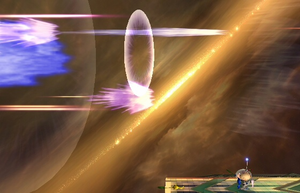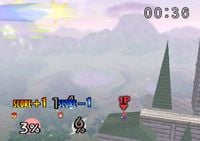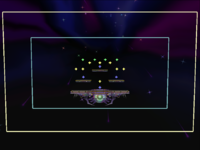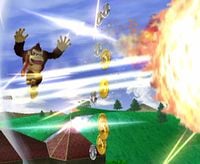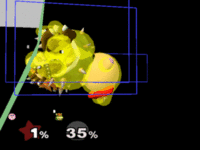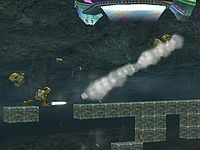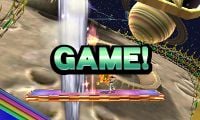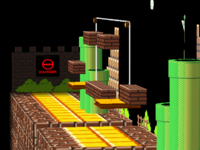Blast line
A blast line is an invisible boundary on a stage that a character cannot cross without getting KO'd, and causing an opponent to go beyond them are the standard means of KOing opponents outside of non-standard modes. Blast lines are usually placed beyond the borders of the screen in which the stage is shown.
There are four blast lines, usually referred to as "bottom"/"lower", "left", "right", and "upper"/"ceiling" (alternatively, "north"/"south"/"east"/"west"). Super Smash Bros. Brawl and Super Smash Bros. 4 display a diagonal-pointing explosion if a character is KO'd in a corner, but this is only to improve the explosion's visibility.
Overview
Most stages have left and right blast lines which are far away from the edges of the stage's platforms, and so cannot readily be walked into. Some stages, however, have what are known as walk-offs, where a stage's platform doesn't stop at a ledge and instead goes all the way to the left and/or right blast line, which allows players to "walk off" the stage's boundaries and be KO'd. The exception is Balloon Fight, where walking off the side of the stage wraps the player around to the other side. There is additionally a lower blast line which is triggered by falling below the bottom of the screen, which is what KO's characters that fail to recover after being knocked off the stage. Some stages have full floors and walls that prevent access to certain blast lines, but they still exist, should a character be glitched through the stage.
The upper blast line is different from the others in that characters can freely pass it without being KO'd in most situations; characters can freely jump and attack above the blast line (the cause of the Luigi ladder). Characters are only KO'd off the top if they are standing on platforms that leave the stage or they are being propelled upwards by knockback, wind, a broken shield, a thrown Screw Attack, or the Wario Waft. These characteristics do not apply in the original Super Smash Bros.; the top blast line in said game will KO characters regardless of how they pass it.
Characters KO'd via the upper blast line are either star KO'd or screen KO'd. There are a few exceptions to this, however. In most battles in 1P Mode where the player fights a large team of opponents, the opponents are KO'd off the upper blast line as if it were any other blast line, instead of being star or screen KO'd. In Brawl, there's a glitch that causes characters who are KO'd over the upper blast line during the usage of a tether recovery to be KO'd with a glitched colored blast. Additionally in Brawl, if a character is KO'd at the upper blast line while near the left or right blast line, they are KO'd as normal instead of star/screen KO'd.
The game's camera refuses to pan or zoom enough during gameplay to actually "see" the blast lines (although the lines themselves are invisible, as can be evidenced when the camera is rotated while pausing). When a character is between a blast line and the camera's view (or above the upper blast line without dying), they will appear in a bubble and slowly take damage. This is known as hoop damage.
Items and projectiles that cross the blast lines are removed from play (except for, again, the upper blast line). A Smash Ball can freely cross blast lines until it leaves gameplay either by disappearing or being used.
The Controls test stage in Brawl and Smash 4 is the only stage in the series to lack blast lines.
In the games
Super Smash Bros.
In the first game, blast zones are fairly big, which makes characters with good recoveries, like Pikachu, live longer on most stages. Despite this, the absence of air dodging and the high hitstun, coupled with the fact there are few characters that boast long, safe recoveries, makes edgeguarding an easy task compared to other Smash titles.
Super Smash Bros. Melee
While the first game previously featured big blast lines, Melee features, for the most part, smaller ones, though there are some exceptions like Dream Land. Combined with the faster falling speeds, this makes edgeguarding technically easier than in the previous game despite the significantly lower hitstun and the introduction of air dodging.
Super Smash Bros. Brawl
Brawl's blast lines seem to retain the same size as Melee's blast lines. However, changes to air dodging as well as the introduction of hitstun and momentum cancelling have made edgeguarding a harder task in the game.
In The Subspace Emissary's side-scrolling stages, the upper blast line is stripped of its unique properties; characters don't need to be in knockback to be KO'd by it and don't fall into the background or foreground. On the other hand, the blast lines are otherwise disabled if the character is not in hitstun; the camera will follow Player 1 and keep them away from the blast lines, while Player 2 will do a Space Jump instead of being KO'd. If a hit is momentum cancelled or otherwise interrupted, the character is still vulnerable to the blast lines for the full duration of the hitstun.
Super Smash Bros. 4
In Super Smash Bros. for Nintendo 3DS, blast lines have become much larger; specifically, most are about 2/3 of the distance of Final Destination. These allow for even lighter characters to live up to 200% damage on smaller stages such as Battlefield. However, it also forces several characters to grab the ledge when recovering instead of just landing on the stage. When combined with the removal of edge-hogging, this allows for many more edgeguarding techniques along with the addition of the edge trump mechanic. Certain returning stages such as Corneria and Onett have their usual smaller blast lines to match their respective original games.
By contrast, Super Smash Bros. for Wii U used to feature the smallest blast lines in the whole series, (with only a select few having big blast lines, like PAC-LAND.) being significantly smaller than in the 3DS version and being in fact smaller than in Melee and Brawl. This makes edgeguarding easier than in the 3DS version, though not as easy as in Melee or 64 where edge-hogging is possible.
In addition, in both versions, Screen and Star KOs no longer happen in the last few seconds of a match (save for an unknown glitch which causes Star KOs and Screen KOs to still happen). They also might not always occur when a character is KO'd across the upper blast line.
Super Smash Bros. Ultimate
Once again, blast lines return. The game also beats Super Smash Bros. for Wii U's smallest blast lines with the Squid Sisters Assist Trophy.
Gallery
The left blast line in Super Smash Bros. at Hyrule Castle.
Melee's Battlefield showing the four blast lines (yellow).
The top end of the trail of clouds shows the top blast line for the underground section of Mushroomy Kingdom.
The upper blast line in Super Smash Bros. for Nintendo 3DS at Rainbow Road.
- Stock Battles (Game!).jpg
The lower blast line in Super Smash Bros. for Wii U at Kalos Pokémon League.
Trivia
- On the Mushroom Kingdom stage of Super Smash Bros. and the Mushroom Kingdom stage of Super Smash Bros. Melee, the camera can be panned far enough to see black signs with a red circle and the word "Danger" off to the side. The sign itself is behind the blast line.
- Sandbag, Master Hand, and Crazy Hand are the only characters that can cross blast lines in Melee. If they cover a great enough distance in either direction, the game will even freeze, as it is too far off the center of the stage for the game to handle.
- While the upper blast line exists in Super Smash Bros. like in other games, KOing a character through it will never result in a blast from above, only in Star KOs or Screen KOs.
